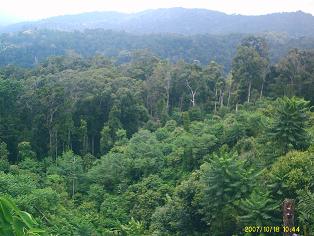|
Indonesian Biodiversity Patterns
| The biological history of Indonesia is one of the least understood in the World (Heaney 1984). This is because of two major factors. First, the immense past and ongoing geological activity of the region has created a complex and fragmented pattern of 17,500 islands. Second, the paucity of tertiary fossil deposits does not allow for a reconstruction of past faunas (Meijaard 2004). What is known is that, generally, isolation of animals and plants on islands for long periods of time provides ample opportunities for speciation events to occur. Long periods of insularity have occurred in Indonesia, such that speciation in Indonesian mammals, for example, dates back hundreds of thousands or even millions of years (Meijaard 2004). The modern biogeography of Indonesia, however, is also greatly impacted by events occurring during the glacial periods, up to as recently as 10,000 years ago, when most Indonesian seas fell about 125 m from their current levels (MacKinnon et al. 1996, Heaney 1986). |

|
During these periods of maximum glaciations, many of the current Indonesian islands were connected by dry land. For example, Sumatra, Borneo and Java (including Bali) were connected to each other and to Peninsular Malaysia by dry land to form a great land mass called Sundaland. It has long been considered that during these intense glacial periods, most species could move freely throughout Sundaland (Heaney 1986). Many of the islands in Nusa Tenggara were also combined into larger groupings, such as Sumbawa, Komodo and Flores. Islands on the Sahul shelf to the east, such as the Aru group of islands, were connected by dry land to both Papua and Australia. Sulawesi, the outer Banda islands and many of the Maluku Islands have not had dry land connections to other islands. Consequently, many of these isolated islands, particularly Sulawesi, retain a high proportion of both unique and endemic species and lower numbers of species that may have originated in the west from the large landmass of Asia via Sundaland (the Oriental Bioregion), or from the east from Australia and New Guinea (Australasian Bioregion) via the Sahul Shelf. Conversely, the islands that formed Sundaland tend to have a large number of species in common, as do those islands on the Sahul shelf.
There are a great number of lines that have been drawn on maps to divide Indonesia into faunal and floral regions (Simpson 1977). Many of these lines are located differently depending on the manner in which the biogeographic data has been analyzed and depending on faunal or floral group studied.

Figure. Indonesia with Sundaland, Wallacea and Sahul Boundaries
|
This Report will use the broad faunal and floral regional groupings of Sundaland, Wallacea and the Sahul, bearing in mind that Wallacea is not considered to be merely a transitional region swamped by species from the adjoining areas, as it is frequently considered to be (see Monk et al. 1997). In fact, Wallacea is a unique region with extensive autochthonous speciation and proportionately a large numbers of endemics; it is an important contributor to the overall megabiodiversity of the Indonesian archipelago (Kitchener et al. 1998 and references therein). |
Source :
Report on Biodiversity and Tropical Forests in Indonesia
Prepared by Steve Rhee, M.E.Sc. Darrell Kitchener, Ph.D.
Tim Brown, Ph.D. Reed Merrill, M.Sc. Russ Dilts, Ph.D. Stacey Tighe, Ph.D. |
|


